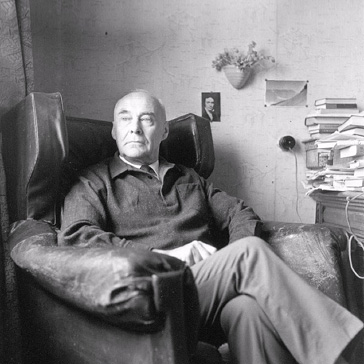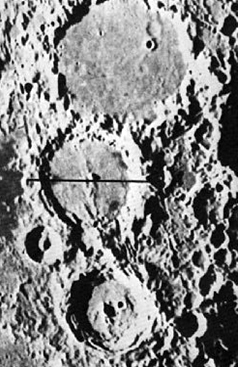Nikolai Kozyrev
Contents
[hide]Nikolai Kozyrev
(Russian Astrophysicist)
Nikolai Aleksandrovich Kozyrev, noted Russian astrophysicist who in 1958 claimed to have discovered evidence of active lunar volcanism. The crater Kozyrev is named after him.
Photo courtesy of Dr. A. Dadaev, Dr. M. S. Chubey and Dr. Dmitri Rabounski - Pulkova Observatory, St. Petersburg, Russia.
Lunar Work
- One of the founders of theoretical astrophysics in the 1930’s in Russia. - JohnMoore2
- Ever since telescopes were first used to observe the Moon, lack of evidence of active volcanism on its surface suggested to many that it was a dead body. However, that all changed on 3 November 1958 when Russian astrophysicist, Nikolai Aleksandrovich Kozyrev, observed what he believed to be a reddish 'cloud' emanating from the central peak of the crater Alphonsus. Using an instrument known as a spectroscope (consisting of a movable slit and collimating lens that can refract light into a frequency spectrum) attached to the 50-inch reflector at the Crimean Astrophysical Observatory, Kozyrev recorded on spectrograms the possible luminescence of volcanic gases escaping from the crater.
- "During the time of exposure the central peak on the spectrograph slit appeared to be brighter and whiter than usual. Suddenly, the brightness of this peak dropped to normal during the time on the order of tens of seconds."..."This circumstance must not be considered accidental....hence we can conjecture that the central peaks of lunar craters may be of a similar origin to the cones of terrestrial volcanoes and are, consequently, gradually accumulated formations."
- The first observation lasted just 30 minutes in all, however, Kozyrev followed it up immediately with another spectrogram that appeared to show intense emissions at 4,737 angstroms. Taking two more observations the following night, the series of spectrograms later analysed by the scientific community would produce gasps of disbelief on the first ever recorded evidence of volcansim on the Moon. Some noted scientists like Czechoslovakian astronomer, Zdenek Kopal, along with American physical chemist, Harold Urey, agreed on Kozyrev's findings, while others like Dutch-American astronomer, Gerard Kuiper, believed the data to be inaccurate and falsified (accusation was later retracted). Several eminent astronomers and observers looking at the crater region afterwards reported seeing red patchs near the site; one, the famous mapmaker, Hugh Percy Wilkins, but others like director of the Lunar Society, Gilbert Fielder, using the 24-inch refractor located at the Pic-du-Midi telescope in France, said he was "unsuccessful". Amidst a time of 'Cold War' environment; of lunar research resources being allocated to other scientific disciplines and; of a newly-formed American administration (NASA) already with plans of lunar exploration in place, Kozyrev's remarkable findings had, literally, opened up a can of worms. An exhaustive scrutiny of the spectrograms showed the volcanic signature to be that of the C2 molecule - a molecular carbon usually associated with volcanoes, however, others saw it as simply a fluorescence of the peak instigated by a burst of solar wind radiation. Whatever the eventual result of occurrences that night of the 3 Nov 1958, the facts remain (through the spectrograms alone) that actual evidence of something extraordinary happened while Kozyrev was at the 'eyepiece. - JohnMoore2
Where & When
Personal Information
Photos
- Several appear in this biographical paper by Alexander Dadaev (See Bibliography below).
Birth
- August 20 (2nd of September by the New Calendar) 1908, St. Petersburg.
Death
- February 27,1983 (buried in the Pulkovo astronomer’s memorial).
Education
Publications
- Spectroscopic Proofs for Existence of Volcanic Processes on the Moon.
- News of the discovery appeared in the soviet issue TASS on 12 Nov 1958, and in several American newspapers like the New York Times (on page 1).
Additional Information
- Pathe newsreel/video (silent) of Kozyrev giving lecture to reporters concerning his purported volcanic discovery. A large moon map (~ 5 feet in diameter) is also seen, along with an image of the Alphonsus spectrogram that cast doubt to his findings.

- Above: Position of the slit (black line across the crater Alphonsus) during the spectrographic observation on the 3 November 1958.
Credit: Dr. A. Dadaev, Dr. M. S. Chubey and Dr. Dmitri Rabounski - Pulkova Observatory, St. Petersburg, Russia.
LPOD Articles
Bibliography
- Daedev, A. N. (2009) Nikolai A. Kozyrev (1908 –1983) - Discoverer of Lunar Volcanism - Letters to Progress in Physics, L3 - L14, Vol 3, July 2009.
- Alter, Dinsmore. 1959. The Kozyrev Observations of Alphonsus. Publications of the Astronomical Society of the Pacific, Vol. 71, No. 418, p. 46.
- Anderson, A. H. (1966) Goddard News: Apparant Activity on Moon's Surf - Goddard News, p 4, July 11, 1966.
- Burley, J. and Middlehurst, B. M. (1966) Apparent Lunar Activity: Historical Review - National Academy of Sciences - Vol 55, No. 5, May 15, 1966.
- Doel, R. E. (2008) The Kozyrev-Kuiper Controversy over Lunar Volcanism: An Episode in Soviet-U.S. Relations
- Kalinyak, A. A.; Kaminonko, L. A. 1962. Microphotometric Analysis of the Emission Flare in the Region of the Central Peak of the Crater Alphonsus on 3 November 1958. in IAU Symposium 14, pp. 273-288
- News & Comments (1969) The Alphonsus Eruption - Irish Astronomical Journal, Vol. 9, p.160, 1969.
- News & Comments (1963) The Alphonsus Eruption - Irish Astronomical Journal, Vol. 6, p.39, 1963.
- Phillips, J. G. and Arpigny C. (1967) Comments on the Identification of the Emission Feature Observed by Kozyrev in the Crater Alphonsus - Astrophysical Journal, Vol. 149, p.275, 1967.
- Kozyrev, N. A. (1962) Spectroscopic Proofs for Existence of Volcanic Processes on the Moon -The Moon, IAU Symposium 14, Academic, pp 263 - 272, 1962.
- Kopal, Z. (1958) "Volcano on the Moon?" The New Scientist.
- Sheehan, W.P. and Dobbins, T.A.; Epic Moon, page 313.